By Aayush Mudgal
Quality education has always been a key factor for an individual and country’s growth. However due to economic, societal barriers, not everyone has had a equal opportunity to educate oneself. Given the limitation to hire an educationist, and impart the right knowledge to students. A student learns from their teachers and idolize the same. Thus in many countries its difficult for the broader population to obtain high quality education. However, education is a basic necessity. With the growing growth of AI capacities, the field of education is becoming more democratised, and having accessibility to such tools to the broader population would have a net positive impact.
History of AI in Education: Pre LLM Era
The integration of Artificial Intelligence (AI) in education traces back to the 1960s and 1970s, marked by the inception of machine learning algorithms and Intelligent Tutoring Systems (ITS) like the PLATO system launched in 1963. The Dartmouth Summer Research Project on Artificial Intelligence, initiated in 1956, accelerated AI research, leading to the development of ITS and advancements such as automated paper marking and personalized learner pathways. Research initiatives like Why-2 Atlas fostered AI-human interactions, yielding practical applications like Duolingo and Carnegie Speech for language learning. Various ITS have been developed for subjects including mathematics, geography, and medical diagnosis, with adoption in U.S. high schools. The rise of online learning, epitomized by MOOCs, has witnessed extensive AI integration, including synchronous, asynchronous, and adaptive learning tools.
Companies like Educational Testing Service and Pearson have introduced automatic NLP assessment tools for standardized testing. These advancements underscore AI’s burgeoning role in education, particularly in supporting lifelong learning through online platforms and continuous professional development.
How is LLM revolutionising the field?
Large language models (LLMs) have been making waves with their remarkable ability to generate text, translate languages, and provide insightful answers. This technique has started to revolutinize many fields, and education included. Lets first understand what these LLMs are at a high level. Word sequence or the order of words plays a crucial role in Large Language Models and language processing in general. The sequence of words determines the meaning of a sentence. In Large Language Models, the sequence of words is used to predict the next word in a sentence. The model is trained on a large corpus of text and learns the probability of a word given the previous words. So, if you input the beginning of a sentence, the model can predict what word is likely to come next, and it does this by understanding the sequence in which words usually appear. Now this same idea can be applied to many different scenarios, including how students interact and learn. For example, in the context of learning programming, the tokens could be thought of words, and order of these tokens define the logic based on the rules of the programming language.
The growth of online massive scale learning systems (MOOCs) like Coursera, Edx, Khan Academy, has made it possible to collect massive scale datasets of diverse student interactions. Online courses not only make widespread education access easier but also help to collect data naturally and help with generating scientific findings and improve learning at scale. There has been massive adoption of deep learning techniques to analyse student engagement, behaviour and outcomes. The powerful LLM techniques based on transformer architecture make it possible to analyze and extract powerful insights which was a limiting factor in traditional ways.
Future of Education in the era of LLMs?
Democratization of Education Access beyond Education Content: The proliferation of MOOCs and online resources offers a wealth of knowledge, yet navigating this can be challenging for beginners. Leveraging LLMs, these systems can serve as comprehensive support mechanisms, acting as doubt resolution and question answering systems, thereby facilitating a smoother learning journey.
Analyzing learning patterns: AI systems enable the analysis of student learning patterns and behaviors, empowering educators to devise more effective teaching strategies tailored to individual needs.
Personalized Tutoring: Adaptive educational systems can pinpoint students’ weak areas and recommend suitable reading materials or problem-solving tasks, fostering personalized learning experiences..
Personalized Questions to prevent plagarism: AI systems can generate unique questions for each student, promoting original thinking and reasoning while mitigating plagiarism risks.
Automated Grading: LLM-based systems excel in knowledge-based reasoning, facilitating efficient and accurate grading of assignments, thereby saving time for educators.
Improved medium of instruction: Advancements in AI technology enable the seamless conversion of written text into audio/video-based courses, enhancing accessibility for differently-abled students. Additionally, AI facilitates easy translation of content across languages, bridging linguistic barriers and promoting inclusivity.
The proliferation of online educational resources has undoubtedly democratized access to learning, with mobile devices and tablets serving as convenient conduits for knowledge acquisition. However, this digital transformation comes with its caveats. The growing reliance on electronic mediums for education has led to concerns regarding the potential erosion of traditional face-to-face social interactions among students.
The author is a deep learning expert, investor and advisor to multiple ML startups and also a 40 Under 40 Data Scientist. He is well known for his significant contribution to the deep learning field.
